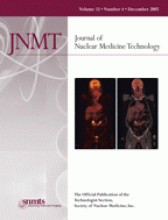Abstract
Objectives: It is widely accepted that exercise-induced stunning has an impact on left ventricular ejection fraction (EF); yet, despite the recommendations of the American Society of Nuclear Cardiology, many departments only perform gated SPECT on stress studies. The aim of this investigation was to determine the relationship between rest EF and stress EF in myocardial perfusion studies and to identify possible predictors of variability.
Methods: This study was a retrospective cross-sectional study of 133 patients (266 studies) undergoing myocardial perfusion SPECT. Automated computer-generated functional data (end-diastolic volume, end-systolic volume [ESV], and EF) for rest and stress studies were correlated as matched pairs and analyzed with respect to the following variables: age, sex, stress method, time between stress and scanning, and presence or absence of pathology scintigraphically. Differences in matched EF pairs (ΔEF) and transient dilatation were also determined.
Results: Matched pairs of rest EF and stress EF demonstrated excellent correlation (0.90) with no significant difference noted (P = 0.15). Bland–Altman analysis demonstrated a mean ΔEF of −0.65% (95% confidence interval [CI], −1.54% to 0.23%) with 94% of data points within the 95% limits of agreement. No statistically significant difference was determined between the mean ΔEF and the hypothetic mean of 0 (P = 0.15). A time between stress and scanning of <45 min was shown to be predictive of a negative ΔEF (P = 0.04). Transient dilatation was shown to be predictive of a negative ΔEF (P = 0.01). Resting ESVs between 25 and 50 mL were shown to be predictive of a negative ΔEF (P = 0.02). A stress EF of <50% was also shown to be predictive of a negative ΔEF (P = 0.003).
Conclusion: No statistically significant difference between stress and rest EF was demonstrated and no trend was identified toward either under- or overestimation of the stress EF with a ΔEF. A negative ΔEF was, however, predicted by transient dilatation of >1.0, a time between stress and scanning of <45 min, a stress EF of <50, and an ESV between 25 and 50 mL. Gated SPECT performed on both stress and rest studies may provide a mechanism to predict exercise-induced stunning and transient dilatation.







